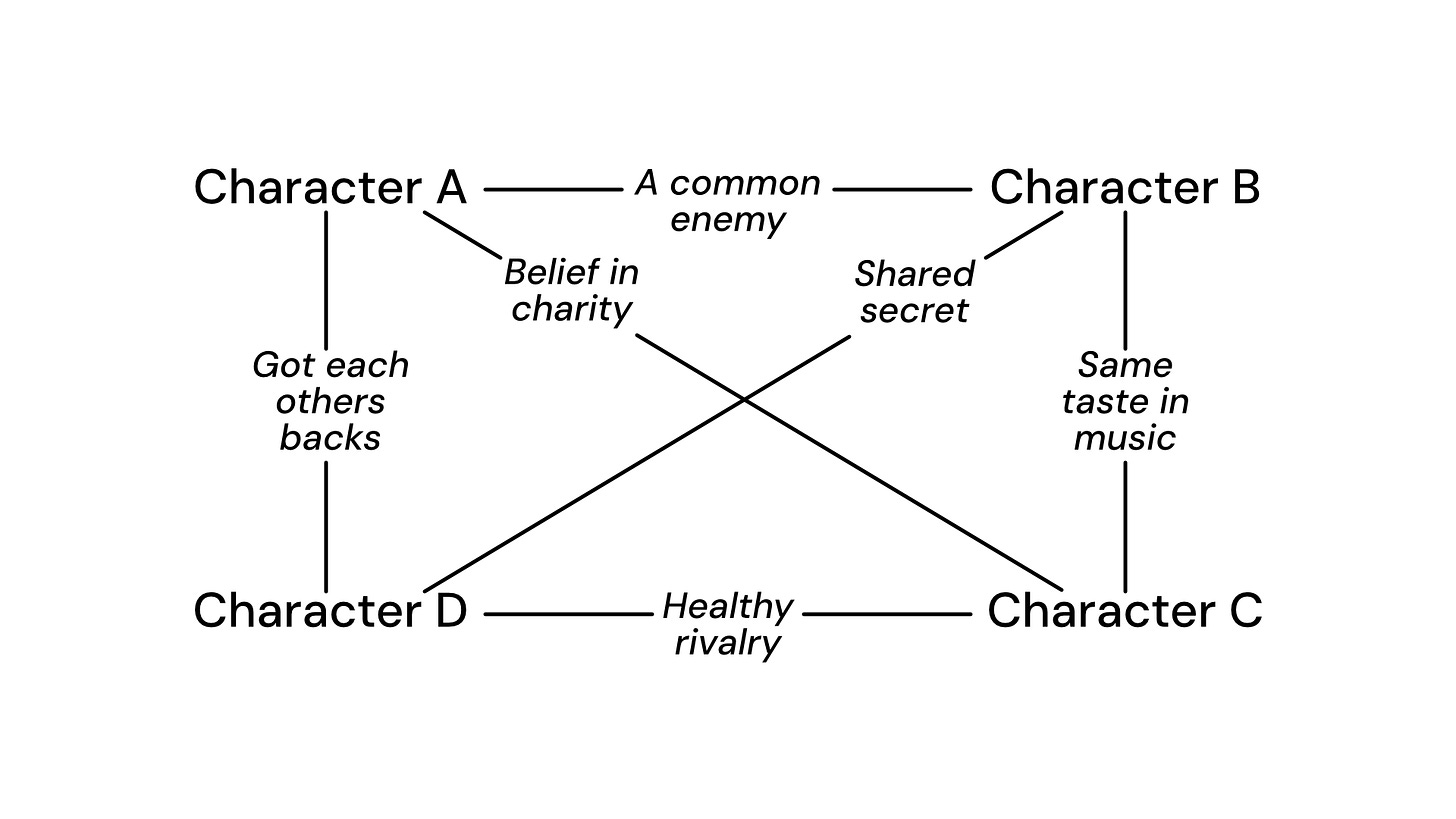This article contains affiliate links, meaning I get a commission if you make purchases using these links, at no cost to you.Last Sunday, we talked about character backstories. This week, let’s connect those characters together.
Beginnings
I want you to forget the situation where the characters don’t know each other at the beginning of a game. It’s awkward, it rarely makes sense, and ‘engineering’ the characters meeting is… yuck.
Let’s skip that. When you start a game, have the characters know each other and be allied to an initial common cause (even if that’s just making a quick buck).
You can start a game without defining any inter-character relationships. If the party has a direction, that’s enough. Let the relationships emerges as the story unfolds.
But if you want more, how do you define character relationships without writing loads (and suffering chronic backstory bloat)?
Character Network
Connect the characters together using a network. Per player, you could decide to not let them know connections between other characters to begin with, they might have to find out through gameplay.
The diagram below shows a party of four characters. The key is that the connections are brief. You can add more detail than on the diagram, but be as focused as possible. Simple things are actionable, many paragraphs describing a connection is too hard to translate to gameplay. Make a strong, short point.
You can use the Goal-Reason framework to drive these connections:
Shared Goals. We both want to find the perfect chocolate bar. The Reasons might be different. Chocolate is the best thing in the world vs the perfect chocolate bar is all that will wake my prince from his slumber.
Shared Reasons. We both love chocolate. The Goals might be different, they might have processed their situations differently. I want the perfect chocolate bar vs I want a spell that makes all food taste like chocolate.
Characters can update their connections as the story progresses, or as Goals and Reasons change. You can expand this network to include NPCs as well if you like.
Some games handle the strain on relationships mechanically. Delta Green is a game that does this quite successfully with agents and their families. Some games also get the players to agree ahead of time what the general function of their party is, like Coriolis: The Third Horizon and Blades in the Dark.
That’s it. A way to create strong, simple relationships between player characters and to record them. Try it and let me know how you get on!
~Psst. If your table doesn’t want character connections fear not, it’s not that necessary.~
This week was special for me. Physical copies of my game Void Above have started to reach backers, and retailer Beyond Cataclysm has copies in their store for sale ~squeals in excitement~. If you didn’t back the Kickstarter, but want a physical copy, check out their store. Me and the team are over the moon.
Recommendations
YouTube: Quinns Quest put out a review of Vaesen, Free League’s folk horror mystery game. I didn’t agree with all the criticisms, but it made me think on mystery games in general and how to make one well.
Blog: Watch Well Games newsletter issue #23 is out, with a focus on character backstories. I contributed a piece to this issue all about integrating backstories into pre-written modules/adventures. K.J. also continues making her innovative community designed game!
Book: Incaseofgrace released a free accessible visual design guide. It’s full of stuff that can help anyone making content for ttrpgs more inclusive.




Love this concept. Creating a chart to unite interests and goals gives you so many more options for viable hooks. My mind immediately goes to a shared enemy who is opposed to the goals or interests of the party. Thanks for getting the creative juices flowing.
Interesting ideas.
It’ll be interesting to see how my players will react with each other in their first group adventure in Tales from Trinity City.
I just released my first introductory solo adventure “Daring Tale” for my new game system.
You can choose one of six characters detailed in the PDF. You go through 11 encounters, and you carry that character over to Welcome to the Projects, which I am going to release for beta testing with the rulebook September - and that’s when you can group with other people!